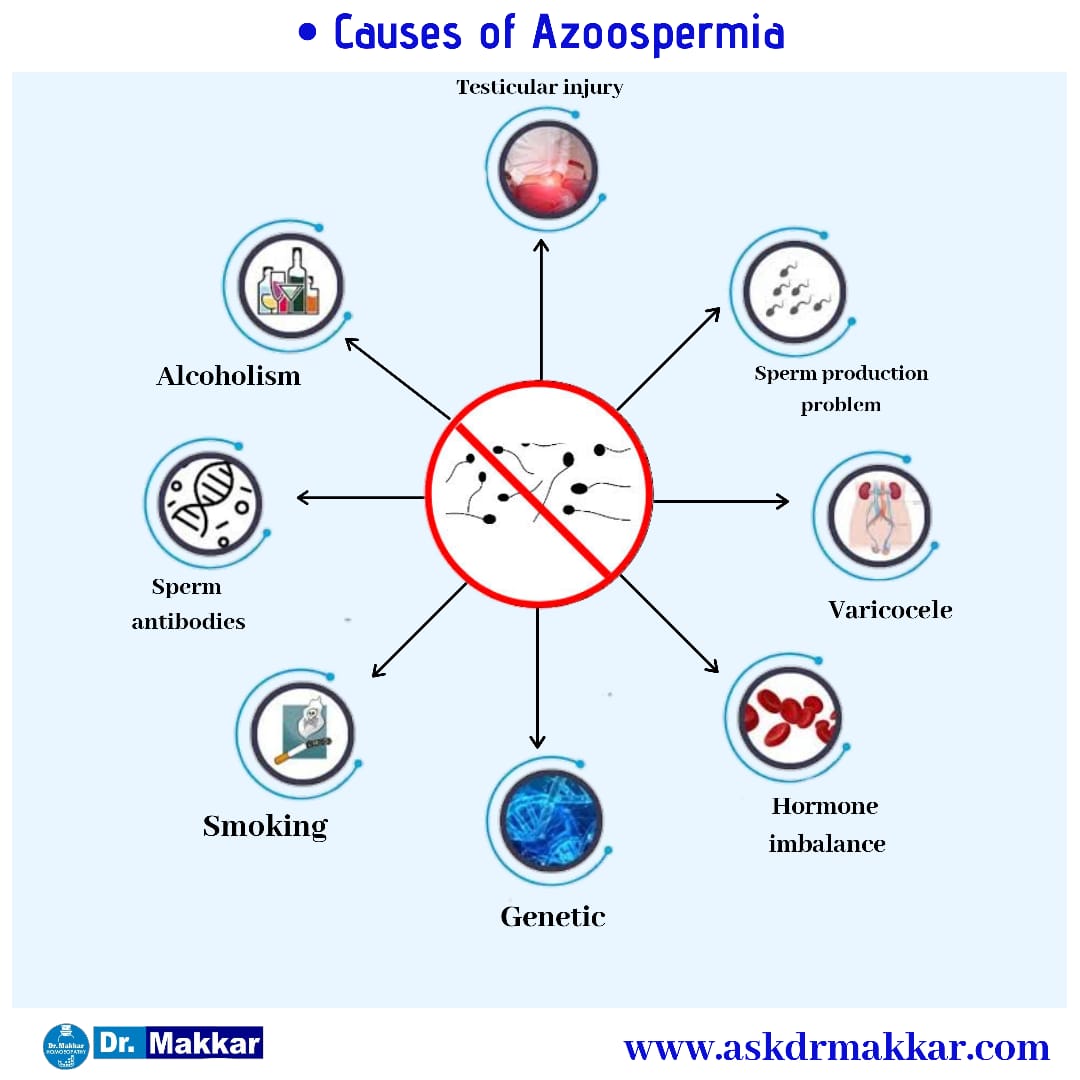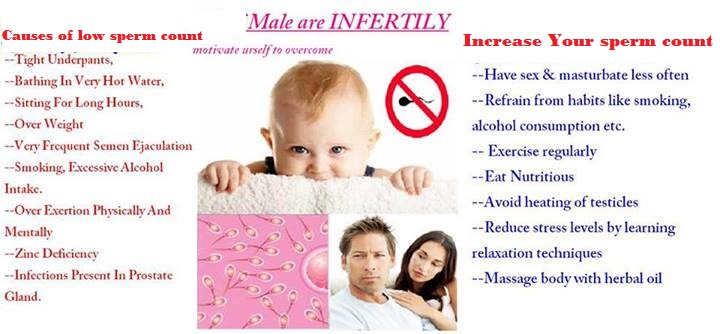The various causes of nil sperm are as follows :
Hormone disorder: The various endocrine (Hormone) disorder leading to azoospermia are as follows
Hormone deficiency of pituitary gland as L.H., F.S.H., Prolactin, thyroids hormone, hypothalmic deficiency of GnRH, Pituitary gland failure, Hypopituitarism, Idiopathic hypopituitarism, Kallman syndrome, Isolated hypogonadotropic hypogonadism, Drugs, toxins, Idiopathic hypogonadotropic hypogonadism & due to many more causes.Obstruction in the outflow of semen (Sperms) from testis to outside through urethral opening. Many times the production of sperms in testis is absolutely normal but these sperm are unable to come out due to obstruction in the out flow tract leading to absent sperms in the semen. The various causes of obstruction are absent vas deferens, absent seminal vesicle, posttraumatic, post surgical ligation of vas deferens. After some infections, as chlamydial, gonococcal urethritis. It may also be due to post tubercular epididimo-orchitis. The sperm may also not come out of testis if the are imotile due to any of the following causes as imotile cilia syndrome, kartagener syndrome cystic fibrosis & many other rare diseases.Absence of germ cells in testis also called sertoli cell only syndrome. In this there are no germs cells i.e. sperm forming cells in the testis. For you knowledge, I wish to inform you that in testis germ cell come to testis from neural cord area of the body during neural cord area of the body during development of fetus. So in some fetuses this migration of sperm cells do not occurs leading to testis only having testosterone forming & sertoli cells. Thus this condition is called sertoli sell only syndrome it is a developmental defect.Maturation Arrest (. Spermatid arrest): of primary spermatocytes to secondary spermatocyte, spermatids or to mature spermatozoa. Due to may local, systemic, hormonal growth factor deficiency or due to idiopathic factor. The various paracrine hormones and growth factors are essential for normal development i.e. maturation of one germ cells to multiplication of ultimately production of multiple mature, normal & motile sperms. Many other factor as infection, varicocele, drugs, chemotherapy may also lead to maturation arrest.

The other causes may by developmentally defective germs cells & spermatocyte. So that they did not have inherent capacity of developing into a mature & motile sperms.Testicular disorders (primary leydig cell dysfunction), Chromosomal (Klinefelter syndrome and variants, XX male gonadal dysgenesis), Defects in androgen biosynthesis, Orchitis (mumps, HIV, other viral, ),Myotonia dystrophica, Toxins (alcohol, opiates, fungicides, insecticides, heavy metals, cotton seed oil), Drugs (cytotoxic drugs, ketoconazole, cimetidine, spironolactone)Varicocele (Grade 3 or more severe): A varicocele is a varicose vein in the cord that connects to the testicle. (A varicose vein is one that is abnormally enlarged and twisted.) Varicocele decreases sperm productions by elevating temperature of the testis, may produce higher levels of nitric oxide chemical in the testis which blocks sperm production, varicocele damages sperms directly & lastly varicocele decrease the oxygen supply to testis.Drugs (e.g. spironolactone, alcohol, ketoconazole, cyclophosphamide, estrogen administration, sulfasalazine)Presence of Antisperm antibody. These Antisperm antibodies bind with sperms & either make them less motile, totally immotile or even dead which is called necrospermia.Trauma Environmental toxinsViral orchitsGranulomatous disease as tuberculosis, sarcoidosis of the testisDefects associated with systemic diseases, Liver diseases, Renal failure, Sickle cell disease, Celiac diseaseNeurological disease as myotonic dystrophyDevelopment and structural defects, Germinal cell aplasia, sertoli cell only syndrome, Cypt-orchidismAndrogen resistanceMycoplasma infectionCystic fibrosis patients often have missing or obstructed vas deferens (the tubes that carry sperm) and hence a low sperm count.Klinefelter syndrome patients carry two X and one Y chromosomes (the norm is one X and one Y), which leads to the destruction of the lining of the sperm forming germ cell in the testis.Environmental Assaults: Over exposure to environmental assaults (toxins, chemicals, infections) can cause nil sperm either by direct suppression of sperm production or on the hormone. Some chemicals that affect sperm production men are: Oxygen-Free Radicals, Estrogen emulation pesticidal chemicals (DDT, aldrin, dieldrin, PCPs, dioxins, and furans), plastic softening chemicals like Phthalates, hydrocarbons (ethylbenzene, benzene, toluene, and xylene)Exposure to Heavy Metals: Chronic exposure to heavy metals such as lead, cadmium, or arsenic may affect sperm production and may cause nil sperms in otherwise healthy men. Trace amounts of these metals in semen seem to inhibit the function of enzymes contained in the sperms, the membrane that covers the head of the sperm.Radiation Treatment: Over-exposure to radiation & xrays affect any rapidly dividing cell, so cells that produce sperm are quite sensitive to radiation damage. Cells exposed to significant levels of radiation may take up to two years to resume normal sperm production, and, in severe circumstances, may never recover.Misuse of substances: There are a number of banned substances that can have potentially lethal effects on sperm production. Taking anabolic steroids, for example, to increase performance in sports such as weight lifting, can dramatically alter both the motility and the health of the spermatozoa. Other banned substances, such as cocaine, marijuana and heroin can reduce sperm production & may make a man infertile.HGH
Stress :- reduces sperm count
Tobacco:- Nicotine damages sperms
Lead :- Workers in printing press have low sperm count
Hot climates
Varicocele
Avoidance of saunas, hot baths, the wearing of tight underwear, and other situations in which scrotal temperature may be raised
Alcohol:- Alcohol damages spermsRecent survey has shown trend in decline sperm count in recent times. There may be many causative factors.